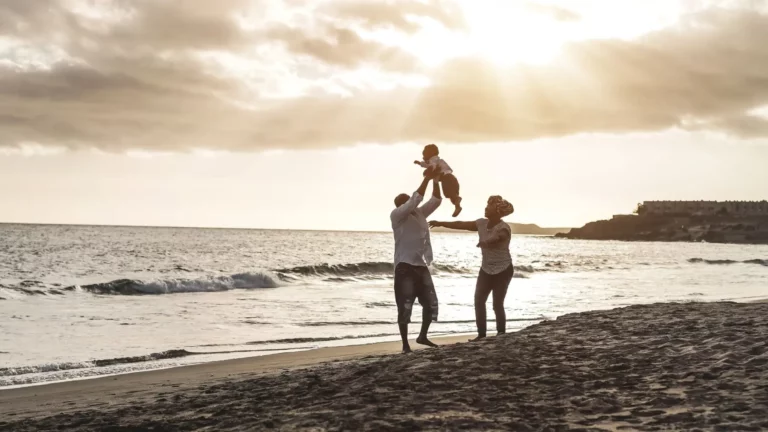Table of Contents
Weekend getaways are one of the most practical ways to recharge without committing to a long vacation. They allow you to step away from routine, explore a new city or countryside, and return refreshed — all without the stress of extended planning or large budgets. But as anyone who’s tried knows, even short trips can quickly become overwhelming if every decision is made from scratch.
That’s where a weekend getaway template comes in. Instead of reinventing the wheel every time, you can use a framework that adapts to different destinations and circumstances. Think of it as a blueprint: a checklist of priorities, a flexible itinerary, and a budgeting system that works whether you’re heading to the beach, the mountains, or a cultural hub.
In this blog, we’ll walk through step-by-step strategies for building your own weekend getaway template — from setting priorities and packing checklists to budgeting and storing your system for future trips.
Why You Need a Weekend Getaway Template
Save Time on Planning
Time is often the biggest barrier to weekend trips. Many people avoid them because planning feels like too much work for such a short break. With a template, however, you’re not starting from zero each time. You already have a structure for what to pack, how to budget, and how to plan your days.
This reduces decision fatigue, the mental strain that comes from making too many choices. Instead of debating what to bring or whether you’ve accounted for everything, you can rely on your template. Over time, this makes weekend trips feel easy and natural, encouraging you to take more of them.
Saving time on planning also means more room for excitement. Instead of stressing over details, you can focus on the fun parts: choosing where to go and imagining what you’ll do once you’re there. The less time spent on logistics, the quicker you can get into a vacation mindset.
Adapt to Any Destination
One of the best things about a template is its flexibility. Whether you’re heading to a bustling city, a quiet beach town, or a mountain retreat, the basic framework remains the same. The details — what to pack, which activities to choose — can be swapped out depending on where you’re going.
For example, your packing list will always include essentials like toiletries, chargers, and a set of versatile clothes. From there, you can add destination-specific items, like hiking boots for a trail trip or swimwear for a coastal getaway. The core structure doesn’t change, but it’s flexible enough to adapt.
This adaptability extends to itineraries too. A three-day getaway always has the same basic rhythm: arrival and settling in, a full day of activity, and a final half-day before returning. Whether that activity is visiting museums or lounging at a spa, the template holds.
Keep Costs in Check
Weekend trips may seem cheap because they’re short, but the costs can escalate quickly. Hotel rates, transportation, meals, and activities all add up. Without a plan, it’s easy to spend more than intended.
A template helps by establishing clear budget categories in advance. You already know how much you typically spend on lodging, food, or transportation. This allows you to slot in estimates for each trip and adjust based on location. Instead of guessing, you’re working from a realistic framework.
By tracking patterns across multiple trips, you also learn where you can save. Maybe you consistently overspend on meals or underestimate transportation costs. A template highlights these areas and allows you to adjust your expectations.
Read related blog: How to Build a Flexible Weekend Getaway Template
Step 1: Define Your Weekend Getaway Priorities
Travel Goals
Before building your template, define what you want from your weekend getaways. Some people seek relaxation, like spa days or beach lounging. Others crave adventure, such as hiking trails or exploring new cities. Knowing your goals shapes how you allocate time and money.
If your primary goal is relaxation, your template might emphasize quiet hotels, minimal scheduled activities, and room for downtime. On the other hand, if adventure is your priority, you’ll want a template that accommodates active excursions and flexible transportation.
Cultural getaways fall somewhere in between. You might focus on museums, local restaurants, or city walking tours. Your template would therefore prioritize centrally located lodging and a mix of scheduled and unscheduled activities.
Distance and Time Limits
Another key step is setting realistic travel limits. A weekend trip usually means two to three days, so destinations must be within reach. Spending six hours on a plane or driving all day reduces the time left to enjoy the destination.
As a general rule, aim for destinations that require no more than four to five hours of total travel each way. This ensures you spend more time at the destination than in transit. For urban areas, this might mean choosing cities within short flights or train rides. For road trips, it’s selecting spots within a few hundred miles.
Budget Expectations
Weekend trips may be short, but they still require budgeting. Establishing typical spending patterns helps you know what’s feasible without overextending yourself. Start by identifying your average budget for transportation, lodging, meals, and activities.
For example, you might allocate 40% of your budget to lodging, 30% to meals, 20% to transportation, and 10% to activities. These ratios can shift depending on the trip, but having a baseline prevents overspending.
Budgeting also encourages smarter choices. Instead of splurging on multiple luxuries, you might prioritize one highlight — a fancy dinner, a concert, or a spa session — and keep other expenses moderate.
Step 2: Create a Reusable Packing Checklist
Essentials That Never Change
Packing is one of the most time-consuming parts of travel, and forgetting essentials can cause unnecessary stress. A reusable checklist eliminates this problem. Your “always pack” list should include clothing basics, toiletries, chargers, travel documents, and any necessary medication.
Having this list ready means you won’t second-guess yourself each time. Instead of starting fresh, you simply tick through your standard items and then add destination-specific extras. Over time, this reduces packing time and eliminates costly last-minute purchases.
It also helps maintain consistency. Whether you’re heading to a nearby city or a distant beach, you’ll always know you’ve covered the basics. That peace of mind frees up energy for the more exciting parts of travel.
Destination-Specific Additions
Once the essentials are packed, the next step is customizing for the destination. Beach trips call for swimsuits, sunscreen, and flip-flops. Hiking weekends need boots, layered clothing, and gear. City breaks may require dressier outfits or portable tech for navigation.
By creating a “swap-in, swap-out” section of your checklist, you adapt quickly without reinventing the list. Instead of writing new lists every time, you maintain categories that can be tailored to the location.
This approach prevents overpacking, too. Many travelers bring far more than they need simply because they’re unsure. A template keeps things efficient: pack only what the destination demands, nothing more.
Tech and Productivity
Tech items are increasingly important for weekend trips. Chargers, power banks, headphones, and travel adapters should always make the essentials list. Forgetting them often leads to unnecessary spending at airports or convenience stores.
For those who combine leisure with work, laptops or tablets may be part of the packing list. In these cases, having a lightweight bag and a portable Wi-Fi device can improve convenience.
Entertainment for travel time is another overlooked item. E-readers, downloaded podcasts, or playlists make flights and drives more enjoyable, ensuring the trip feels like a break rather than just transit.
How Packing Light Saves Money on Baggage Fees
Packing light isn’t just about convenience; it saves money too. Airlines often charge for checked luggage, and even budget carriers now charge for carry-ons beyond a small personal item. Keeping baggage lean prevents these fees from inflating your total cost.
By sticking to your checklist and learning to pack strategically, you maximize savings without sacrificing essentials. This makes your weekend getaways not just simpler, but also more affordable.
Knowing how much you spend helps identify areas for improvement. You can set financial goals based on what you find. Beem’s Spending & Budgeting tool makes it easy to categorize transactions.
Step 3: Plan a Flexible Itinerary Framework
Day 1: Arrival and Exploration
The first day of a weekend trip sets the tone. After traveling, energy levels are often lower, so the itinerary should be light but rewarding. Aim for one main activity and an easy evening plan.
For example, after checking in, you might explore a nearby neighborhood, enjoy a casual dinner, or take a short walk around the city. The goal isn’t to pack the day but to ease into the trip.
Day 2: Core Experience
The second day is the heart of any weekend getaway. This is when you schedule your main activity or highlight. Whether it’s a hike, museum tour, spa visit, or day at the beach, this is the experience you’ll likely remember most.
Start early to maximize time, but don’t overload the schedule. One or two key activities are usually enough. Adding too much can leave you rushing and unable to fully enjoy the experience.
Day 3: Wind Down and Return
The final day should ease you back into routine life. Plan for a short activity in the morning — a relaxed breakfast, a walk in the park, or a quick local stop. Avoid booking anything that risks making you late for your return.
Buffer time is important. Travel disruptions can happen, and the stress of a tight schedule can undo the benefits of the getaway. Keep this day light and flexible. Using the last day for rest ensures you return home energized rather than drained. It also helps you re-enter the workweek smoothly.
Read related blog: How to Plan Weekend Getaways Without Overspending
Step 4: Budget for Predictable Categories
Transportation
Transportation is often the biggest expense after lodging. It includes flights, train tickets, rental cars, or gas. For weekend trips, last-minute fares can be pricey, so planning ahead helps secure deals.
Budget airlines may seem cheaper, but remember to factor in baggage fees and secondary airport transfers. Rental cars add flexibility but can include hidden costs like fuel and insurance.
By categorizing transportation early in your budget, you avoid surprises. Knowing your typical spend for this category lets you quickly adjust for each new trip.
Accommodation
Lodging can eat up a large portion of the weekend budget. Hotels, Airbnbs, and hostels all have pros and cons. For short trips, location matters more than luxury. Staying close to your activities saves both time and transport costs.
Budgeting for accommodation upfront prevents overspending. Decide whether you prefer affordable stays that free up money for experiences, or whether comfort is worth the extra cost.
Food and Activities
Meals and activities vary widely depending on the destination, but they’re always central to the experience. Budgeting for them ensures you don’t overspend on impulse.
Divide the food budget between planned meals and spontaneous finds. For activities, allocate enough for one or two highlights while keeping a buffer for unexpected opportunities.
Using Beem’s Budget Planner
Beem’s Budget Planner is an excellent tool for managing weekend trip expenses. It allows you to pre-set categories for transportation, lodging, food, and activities, making it easy to see how much each trip will cost.
The planner also adapts in real time. If you overspend in one category, you can adjust in another. For example, a pricier dinner can be balanced by a free activity the next day.
By tracking expenses during the trip, Beem helps you avoid surprises when you return home. It also saves leftover funds for future getaways, creating a sustainable cycle.
Read related blog: Building a ‘No-Spend’ Weekend Routine: Why & How
Step 5: Build Flexibility Into Every Trip
Leave Room for Spontaneity
The temptation during short trips is to cram in as much as possible. But overplanning leaves no space for surprises, which often turn out to be the best memories.
Your template should always include free time. A two-hour block without commitments can lead to discovering a street festival, stumbling on a scenic viewpoint, or just relaxing without pressure.
Leaving room for spontaneity also reduces stress. If something doesn’t go as planned, you have time to adjust. This flexibility ensures small disruptions don’t ruin the whole trip.
Mix of Paid and Free Experiences
Not every activity needs a ticket or reservation. Mixing paid highlights with free experiences stretches your budget and enriches your trip.
Museums, guided tours, and excursions may cost money, but local markets, public parks, and neighborhood walks are often free. Combining both creates variety without overspending.
This balance also prevents burnout. Constantly moving from one paid attraction to another can feel exhausting. Free activities provide a slower pace and a chance to connect with the destination more authentically.
Plan for Weather and Delays
Weekend trips are short, so disruptions hit harder. Rain can cancel a beach day, and delays can eat into limited time. Having backup plans prevents disappointment.
Always include both indoor and outdoor options in your itinerary. If the weather shifts, you can pivot easily without wasting the day.
Beem gives users access to helpful financial tips and resources. Like many banks, Beem offers free budgeting planner to help you manage your finances better. They can help manage money better and grow savings. This tool helps categorize transactions for easy budgeting.
Step 6: Store and Reuse Your Template
Digital Template Options
Storing your template digitally makes it easy to access and update. Apps, spreadsheets, or Beem’s Budget Planner are ideal for this. Cloud storage ensures you can pull up your template anytime, anywhere.
Digital formats allow quick adjustments. You can duplicate your template for each new trip and tweak details without rebuilding it from scratch. They also integrate with other tools, like maps or itinerary planners, making your planning process seamless.
Physical Template Options
Some people prefer tangible tools. A printed checklist, dedicated notebook, or folder for travel documents can work just as well. Physical templates provide a sense of satisfaction when checking off items.
They also reduce reliance on devices, which can be useful if you prefer to unplug during your getaway. A small, travel-sized notebook can hold packing lists, itineraries, and budget notes all in one place.
Physical options also work well for families or groups. Passing around a checklist ensures everyone knows what’s covered.
Updating After Each Trip
The strength of a template lies in refinement. After each trip, review what worked and what didn’t. Did you pack too much? Overspend on meals? Run out of time for activities? Add these lessons into your template for next time.
Over months and years, your template evolves into a personalized playbook perfectly suited to your travel style. This constant improvement makes each getaway smoother and more cost-effective than the last.
Read related blog: Trip Cost Post-Mortem: Learn and Save More Next Time
FAQs
1. How can I plan a weekend getaway quickly without overspending?
The key is preparation. Using a template ensures you have a packing list, itinerary structure, and budget categories already in place. This eliminates last-minute decisions that often lead to overspending.
2. What should always be included in a weekend packing list?
Essentials like toiletries, chargers, travel documents, and versatile clothing should always be included. These core items remain the same regardless of destination.
3. How do I balance structure and flexibility in a short trip?
Use a framework that assigns a purpose to each day: light arrival, core experience, and relaxed departure. Within that, leave space for unplanned discoveries. This balance ensures you experience the highlights without feeling rushed or missing spontaneous opportunities.
4. Can a weekend getaway template work for international trips?
Yes, though international trips may require more preparation for documents, currency, and longer travel times. The core structure still applies: define priorities, budget smartly, and build flexibility. The difference is allocating extra buffer time to account for flights and potential delays.
5. How does Beem’s Budget Planner make weekend getaways easier to manage?
Beem’s Budget Planner allows you to set categories for transportation, lodging, meals, and activities before the trip begins. You can track spending in real time and adjust on the go. This ensures your trips stay within budget and helps you save for future getaways. It makes planning less stressful and execution more enjoyable.
Conclusion
Weekend getaways don’t have to be stressful or expensive. With a flexible template, you can streamline packing, plan realistic itineraries, and keep your travel spending in check. Whether you’re escaping to the mountains, exploring a nearby city, or unwinding at the beach, a repeatable framework makes quick trips easier to plan and more affordable to enjoy.
Using Beem’s Budget Planner, you can outline trip expenses in advance, set spending limits for travel, food, and activities, and adjust in real time. If unexpected costs arise — like a last-minute hotel upgrade or car rental deposit — Beem Everdraft™ provides instant cash access up to $1,000, with no credit checks or interest. Meanwhile, Beem’s Smart Wallet and Cashflow AI tools help you manage money seamlessly, while Job Loss Protect™ gives you peace of mind that your future trips stay secure, no matter what life brings.
Make every weekend getaway smooth, spontaneous, and financially stress-free — download the Beem app today to plan smarter, spend wisely, and travel with confidence.















































